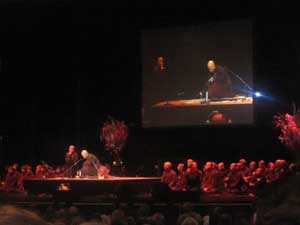 On Friday I was lucky enough to attend a dharma talk with beloved Vietnamese Buddhist monk Thich Nhat Hanh organized by Omega Institute.
On Friday I was lucky enough to attend a dharma talk with beloved Vietnamese Buddhist monk Thich Nhat Hanh organized by Omega Institute.
With each of the Beacon Theatre’s 2,800-plus seats full, the evening began with brown-robed monks–men on the right, women on the left–singing beautifully. When Thich Nhat Hanh approached the stage, he seemed small but sure before sitting down cross-legged on some raised cusions–not bad for someone who turned 83 yesterday. (Happy Birthday!).
And then he talked in the loveliest and sweetest way about how we can be happy in any moment–and we will only be happy when we are actually in this moment. Not the last one or the next one, but arriving into the real, actual home of right now.
For some reason no matter how many times I hear it, this message never gets old. Possibly, because for me, at least, it never gets fully learned. Like observing the breath in meditation, it is something I have to come back to again and again. And it was fascinating to be sitting in a room full of presumably relatively typical New Yorkers doing this. The only signal that this wasn’t a 100 percent “normal” theater crowd was the occasional mala bracelet peeking from a button-down shirt sleeve. So it was kind a hilarious and wonderful to be aware of my fellow New Yorkers in their gruffness and toughness listening to things like, “Breathing in, I see myself as a flower. Breathing out, I feel fresh.”
![]() In my own discomfort at seeing someone so sincere and free of ironic detachment, I actually had to hold back a few inapprppriately timed giggles–like a fifth grader at a sex talk. He said we are all born as flowers–when you look at the face of a child, it’s a flower. And as we suffer and then avoid our suffering that flower-essence can dim. But it’s possible to “restore our freshness” (tee) at any moment with mindfulness–something we can develop with meditation.
In my own discomfort at seeing someone so sincere and free of ironic detachment, I actually had to hold back a few inapprppriately timed giggles–like a fifth grader at a sex talk. He said we are all born as flowers–when you look at the face of a child, it’s a flower. And as we suffer and then avoid our suffering that flower-essence can dim. But it’s possible to “restore our freshness” (tee) at any moment with mindfulness–something we can develop with meditation.
Some more Thich Nhat Hanh quotes from the evening:
“Most people are afraid of suffering. But suffering is a kind of mud to help the lotus flower grow. There cannot be a lotus flower without the mud.”
“We try to cover up the suffering in us by way of consuming. We turn on the television, we talk on the phone. We get on the internet. We read the pages of a novel… Many of the items we consume every day are highly toxic.” Because they are filled with “anger, violence, and despair.”
“To consume in order to cover up our suffering does not work. We need a spiritual practice to go deep into our suffering.”
“In order to come home to ourselves without fear of encountering the suffering, we must have a practice of mindfulness and concentration.”
He quoted the Buddha’s first meditation teaching. You say to yourself: “Breathing in, I know this is my in-breath. Breathing out, I know this is my out-breath.”
“Breathing in, I’m aware of my eyes, breathing out, I smile to my eyes.”
“Breathing in, I’m aware of my whole body. Breathing out, I release the pain in my body.”
[If you suddenly feel pure joy while you’re with a beloved] “you can wake the person up and say ‘darling, this is a happy moment.'”
“As an organic gardener, you are not afraid of the garbage. It can always be transformed to make a beautiful flower.”
“Love is a beautiful flower, but if you don’t know how to handle the flower, it will be garbage in one year or less… But we can look into the nature of the flower.”
Then he spoke of doing mindfulness work in a group, a sangha of like-minded supporters. “The collective energy will help us transform the suffering in us.”
He also spoke about walking meditation, how with each step–or every few steps–we can place our foot and think: “I have arrived.” He said to arrive with each of those steps 100 percent into the present. But, and this got a chuckle, “If it happens that you haven’t arrived 100 percent, stay there and take another step.” He said all mindfulness practices requite “a determination to stop the running.” He means a determination to stop running away from pain, suffering, anger, sorrow–the grittier parts of ourselves.
Thank you, Thich Nhat Hanh and Omega.
For more info on Thich Nhat Hanh:
[Images by Valerie Reiss]
Like what you see? Click here to subscribe and get Fresh Living in your in-box every day!

